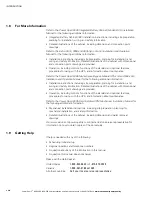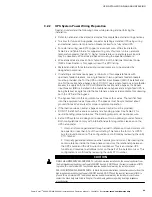
INTRODUCTION
Power Xpert
9395 UPS (450–550 kVA) Installation and Operation Manual
164201701 Rev 3
www.eaton.com/powerquality
1-6
1.2.8
Input Output Module Configuration
The UPS can be supplied in an Input Output Module (IOM) configuration without the
bypass input connections, the static switch, the motorized wraparound bypass
breaker, and the backfeed protection contactor. This configuration is primarily used in
multiple UPS parallel systems that do not need a bypass for each UPS and use a
separate System Bypass Module (SBM) to provide system bypass capabilities.
1.2.9
Inherent Redundancy
To deliver greater reliability, the Power Xpert 9395 UPS can be configured by an
authorized Eaton Customer Service Engineer
for inherent redundancy. When
configured, the UPS automatically becomes redundant if the load is at or below the
capacity of the UPMs minus the capacity of one UPM. Under normal conditions the
UPMs in the UPS share the load equally. If one or more UPMs becomes unavailable
and the load is at or below the capacity of remaining UPMs, the remaining UPMs
supply the load instead of transferring to bypass.
If the capacity of the UPMs falls below the redundancy level or the load increases
above redundancy level, but is still able to maintain the load, a loss of redundancy
alarm is sounded. If the load exceeds the capacity of remaining UPMs, the UPS
transfers to bypass.
1.2.10
Energy Saver and High Alert Modes
Energy Saver mode allows the UPS to operate in Bypass mode. In this mode, the
UPS is operating on bypass, with the UPMs in standby, ready to automatically
transfer to Normal mode if a commercial electrical power brownout, blackout,
overvoltage, undervoltage, or out‐of‐tolerance frequency condition occurs.
In High Alert mode the unit transfers from Energy Saver mode to Normal mode
(inverter online) or if in Normal mode remains in Normal mode for a default time
period of one hour. The High Alert mode time period is configurable by an Eaton
Customer Service Engineer. High Alert mode allows the user to place the unit online
with full protection when outside conditions could cause a power disturbance. At the
completion of the time period, the unit defaults back to Energy Saver mode. If the
High Alert command is received during the time period, the timer will be restarted.
1.2.11
Monitoring and Communication
Remote Monitor Panel II (RMP II)
– An optional RMP II contains backlit status
indicators and a local horn, allowing monitoring of the operational status and alarm
condition of the UPS from virtually any location within the facility.
Relay Interface Module II (RIM II)
– An optional RIM II uses relay contact closures to
indicate the UPS operating status and alarm condition.
Supervisory Contact Module II (SCM II)
– An optional SCM II establishes an interface
between the UPS system equipment and the customer's monitor.
X-Slot Cards
– Optional X-Slot cards support several protocols, such as SNMP,
HTTP, IBM
®
AS/400
®
, and Modbus
®
.















































